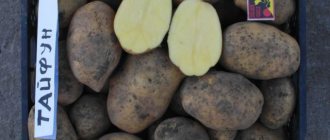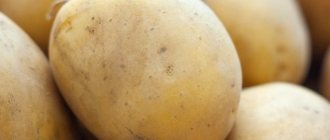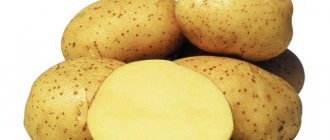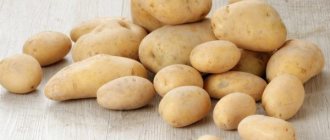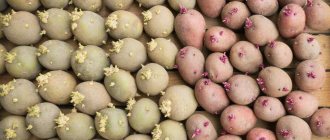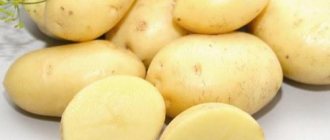Impala potatoes are considered early ripening. It belongs to the table varieties. They brought him out in Holland. You can harvest these vegetables 2 times per season. Potatoes fully ripen 60 or a maximum of 75 days after planting, but gardeners say that the first potatoes can be dug out from under the bushes and eaten as early as 45 days after planting, or even 40.
Description
Potato bushes grow up to 75 cm. They are bushy, with a lot of medium foliage on 4 or 5 stems. It is rich green. The edges of the leaves are slightly wavy. The inflorescences contain white flowers with a yellow center.
Potatoes are oval with small eyes. They are only slightly recessed into the vegetable, which has a light yellow skin that is smooth to the touch. 1 vegetable weighs from 120 to 160 g, but there are also smaller or larger specimens.
Impala is a mid-early variety. It is believed that vegetables fully ripen from 60 to 75 days after potato sprouts sprout. .
"Important! You can dig up and eat vegetables from day 45.”
Gardeners who plant these fruits for the first time are pleased with them. They are beautiful and delicious. You can thoroughly stock up on them for the winter.
History of selection and distribution
The variety was bred in the early 1990s in the Netherlands. In Russia it was officially registered in 1995, in Ukraine and Belarus - in 2000.
On the territory of the Russian Federation it is allowed for cultivation in four regions:
- Volga-Vyatka (Chuvashia, Mari-El, Udmurtia, Perm region, Sverdlovsk, Kirov and Nizhny Novgorod regions);
- Central (Moscow, Tula, Ryazan, Bryansk, Kaluga, Ivanovo, Smolensk, Vladimir regions);
- Nizhnevolzhsky (Kalmykia, Volgograd, Saratov and Astrakhan regions);
- Northwestern (Leningrad, Kaliningrad, Novgorod, Yaroslavl, Pskov, Tver regions).
Important! Often the root crops of this plant are popularly called “Kubanka” or “Crimean”.
Characteristics
Let's look at the main characteristics:
- She matures quickly. The variety is early ripening. Depending on the climate, root vegetables will fully ripen from 60 to 75 days, and the first potatoes can be dug up and prepared for various dishes already from 45 (even 40) days after the sprouts appear.
- Tolerates drought well. Don't worry, if there is little rain during the season, the potatoes will not go to waste. The owner can water it additionally.
- Grows well in any soil. There will be more vegetables in an open space than in a greenhouse.
- After harvesting, the owner will find that 98% are in excellent condition, without rot or any damage.
- These potatoes can be eaten immediately or stored for a long time, eaten by the whole family little by little. If the basement or cellar is dry and the vegetables are not damaged, they will be 100% preserved until spring.
You can store them in boxes and bags. In addition to the cellar and basement, townspeople keep vegetables on the balcony, on the lower shelves in the refrigerator. Potatoes can be peeled and frozen.
Harvest and storage
40-60 days after the first shoots emerge, the harvest can be harvested. It is not recommended to do this before the due date, as the potatoes will have a peculiar, not entirely pleasant taste.
You can determine whether the tubers are fully ripe using the following methods:
- Count three weeks from the flowering period. This method is not entirely accurate due to possible differences in climatic conditions.
- Dig up one bush and assess the condition of the tubers.
- Pay attention to the general condition of the bush. If the lower leaves begin to turn yellow and the branches fall to the ground, you can safely begin harvesting.
After harvesting the potatoes, it is necessary to dry them in a well-ventilated, dry place. The crop should be protected from direct sunlight, this can lead to its unusability, as the root crops will turn green.
It is recommended to store potatoes in a single layer in a ventilated area. From time to time the condition of the tubers is checked. If the fruits are planned to be prepared as seeds for planting, they, on the contrary, should be placed in the sun and allowed to turn green. Compliance with these measures helps to reduce the starch content and increase the sugar and acid content.
What kind of harvest you get when planting Impala potatoes can be clearly seen in the following video:
Productivity, taste
Impala is spreading quickly in villages and among summer residents. Gardeners harvest 15 kg of vegetables from 1 bush. If the soil is well fertilized and the plantation is watered in dry weather, then 1 bush can produce from 17 to 21 kg of root crops.
Growing on an industrial scale, farmers harvest 37-60 tons per hectare. In the south of Russia, these root crops produce 2 harvests. The owner will find from 16 to 21 root crops in 1 bush. It is best to dig up an early harvest when it is cloudy, then you can pour water into the same hole and plant the bush again. It will produce new tubers. Thus, in the southern regions it is possible to increase productivity by 1.5 times.
The skin of root vegetables is dense. If the owner does not touch the potatoes when digging, then they will be smooth, beautiful, and without damage. Each season, 98% of those collected are in excellent condition. The thick skin facilitates excellent storage. Winter will pass, and these vegetables will not sprout. Potatoes of other varieties most often germinate by spring.
Impala grows well in any soil. If there is a lot of rain during the season, the soil is well fertilized, then the harvest will be higher, but even when there is little rain, the owner will collect enough vegetables.
During heat treatment, potatoes have little friability. The puree will be light and of medium consistency.
How to get a higher yield?
To ensure high yields, gardeners who have been growing Impala on their plots for a long time recommend taking into account a number of subtleties. When planting potatoes, add 0.7 kg of humus + 5 tbsp to the hole. l. ash, then there will be more vegetables than last season without these fertilizers.
Adding onion peels to the wells has worked well. Its smell repels wireworms and Colorado potato beetles. If the owner trusts industrial fertilizers, then he can take 20 g of Kemira Potato or 1 tbsp. l. nitrophoska.
It is best when the furrow for planting seed material is dug in the ground from north to south. Plants will receive the maximum amount of heat and sunlight. This contributes to high yields.
In order for seed potatoes to begin to grow quickly, the soil must be warmed to at least +7°C when planting. When the air temperature is +22–25°C, these are favorable conditions for the active growth of seedlings. If it is too hot +25°C or frost hits, the growth of potatoes will be delayed. In some beds the sprouts will emerge faster, in others later. This means that in some bushes the potatoes will ripen earlier, in others later.
Fertilizing is required to be applied 3 times during the entire period of potato growth and ripening. When the tops are just starting to grow, add 1 tsp of ammonium nitrate to the root. or humus - 1.5 cups. You can also make an infusion from chicken droppings and pour it over the soil at the roots. You will need 10 g of dry litter; it is diluted with water 1:20.
Mullein infusion is considered the highest quality and natural fertilizer. Dilute it 1:10. When plants form buds, they require increased amounts of potassium. You can take potassium sulfate (10 g) + ash (2 handfuls) for 1 bush. When the Impala potatoes fade, in order to plant abundant root crops under the roots, you need to add a solution that will nourish the seedlings. For 10 liters of water, 20 g of mullein + superphosphate (2 tbsp.) is required.
To make it easier to care for the beds and not have to frequently weed them, it is best to mulch the free space between the rows, from bush to bush. For mulch, use straw, sawdust, and fresh grass. It is impossible to water a mulched area often, because this layer already retains water. It evaporates less.
Some gardeners cover the area with special black agrofibre. This is a film that does not let the sun's rays through. Each potato sprout needs to be threaded through the film so that it is outside and receives a lot of light and heat. Without sun and sufficient air, the weeds under the film will die.
Features of cultivation
The best harvest can be obtained on light to medium soils. The Impala variety produces a stable yield in dry and rainy years, but maximum yield is observed with moderate soil moisture. Cultivation is also practiced indoors, under film cover. But the variety is better cultivated in open ground.
It is recommended to start planting in open ground in the first ten days of April. In 45 days, potatoes will delight you with your first harvest. The ripening time is determined by the climatic characteristics of the area.
The big advantage of this potato variety is that when planting the material, no preliminary germination is required. This makes it possible to get a good harvest in less time.
Despite this, if you want to get the harvest as early as possible, it is advisable to germinate the potatoes in advance. For this purpose, the tubers are kept in a box in daylight for about thirty days. First at a temperature of +18-25°C, and then the degree is lowered to +12-15°C.
For more information about germination, read the article Preparing germination and treatment of tubers from diseases and pests
Healthy! To obtain an extra-early harvest, it is possible to grow potato seedlings in pots. Potatoes take about a month to germinate, so in order to plant seedlings in open ground in April, you need to plant the tubers in mid-March.
In fact, growing Impala potato is practically no different from growing any other seedlings. Just like with other plants, the pot must be placed in a warm place and the humidity must be maintained using film. That is, cover the pot with film. When the potatoes sprout, this cover must be removed. As soon as the soil reaches the desired temperature, the bushes along with the soil can be planted in the soil.
Regardless of the planting method you use, you need to follow a few guidelines for preparing potatoes:
- As a rule, potatoes are planted in the ground no earlier than mid-April;
- The ideal planting material is intact, medium-sized tubers. It is desirable that the number of eyes on the potatoes be maximum;
- Before planting tubers in open ground, treat them with disinfecting solutions. To do this, it is necessary to keep the potatoes in the solution for at least 45 minutes;
- You need to be extremely careful with the eyes, as damage to them can lead to a slowdown in potato development.
Watch the video! Planting Impala potatoes
In general, the process of planting this type of potato is simple, but you should pay attention to some planting conditions, because otherwise you will not be able to achieve the desired result.
To obtain the desired harvest, follow these recommendations:
- It is not recommended to plant potatoes more than once in the same place, or in a place where crops such as peppers or tomatoes were previously grown;
- the Impala variety in a place where perennial grasses, winter cereals, and legumes previously grew;
- Be sure to ensure that the soil for planting is sufficiently warm, loose and moist. You should not rush and plant potatoes too early, but remember that the plant feels more comfortable in moist soil, so it is advisable to plant potatoes while the soil is moist after the snow has melted;
- the Impala variety in ridges at least 10 centimeters high. The distance between bushes should not exceed 30 cm, and between rows up to 50 cm;
- Despite the fact that the variety can develop quite successfully in dry soil, it is advisable not to forget to water the bushes during drought, since in this case the potato productivity will increase significantly;
- When the bushes reach a height of 15 cm, they should be hilled. In the future, this procedure will be repeated;
- It is advisable to sometimes loosen the gaps between the rows, removing weeds;
- If necessary, treat bushes for pests. You can read about this Treatment of potatoes against the Colorado potato beetle: folk and chemical means of pest control
Read about how to plant potatoes correctly in the article Methods, diagrams and rules for planting potatoes in open ground
Did you know? Since the variety ripens in 1.5 months and has a marketable white color, it is mainly grown as new potatoes. Therefore, the first non-GMO potato to appear on the market, which is loved not only by producers, but also by consumers, is Impala.
Since Impala potatoes produce well in medium-humidity environments, watering should be moderate.
This variety is stored in the same way as others. The dug up potatoes must be thoroughly dried, placed in boxes or nets and placed in a dry cellar. the Impala's shelf life will be quite long.
Potato Impala , like other early varieties, welcomes mineral and organic fertilizers, as this is an additional resource of heat and nutrients. The application of manure improves the development of potatoes.
It is advisable to apply rotted manure to the soil in early spring before plowing the land. This helps improve the soil and increases its fertility.
Fertilizers of mineral origin should be applied in small portions, since an overdose of some of them (especially nitrogen) has a negative effect on the taste of potatoes. Additives containing phosphorus and potassium are applied only in the autumn. When using mineral fertilizers, you must always follow the recommendations on the packaging.
When potatoes are in the growing season, fertilizing is usually not done.
Healthy! By reusing the bush, the potato yield can be increased by about one and a half times. In more or less humid weather, it is necessary to dig up the bush, after which the largest potatoes should be picked and the small ones left. Then plant the bush a second time, not forgetting to water it thoroughly. After about a month, the bush will form new tubers, and the small ones will become large.
In general, agricultural technology for this variety is standard and contains the usual activities: loosening, watering, mulching, hilling, fertilizing.
You will be interested in: How and how to fertilize potatoes in the spring, when planting in a hole, in summer and autumn, rules for preparing a potato bed
How to Hill Potatoes: When, How Correctly and What to Hill Up
Advantages, with disadvantages
In Russia, Impala potatoes are grown both in villages and by summer residents. It has many advantages, which is why it has become popular.
Let's look at the main ones:
- The variety ripens early. Depending on whether the southern region or the central region is different, how warm it is there, the seed material will need 45-75 days to grow.
- Even and smooth vegetables have a marketable appearance.
- Regardless of weather conditions, the harvest will be good. In the south you can collect 2.
- It grows well both in temporary drought and in abundant rain. This means that root crops can be grown in many regions of Russia.
- Various soils are suitable. There will be more fruits in open soil than in a greenhouse.
- Potatoes are used in the preparation of 1, 2, various dishes and snacks.
- Vegetables are stored for a long time and look great, maintaining high taste.
- Potatoes are resistant to physical damage. The owner collects the harvest and sees that 98% are in excellent condition.
- Resistance to neoplasms, with nematode.
- In 50 days, the potatoes grow large and can be harvested.
- If there is a lot of rain during the season, the potatoes will suffer from some diseases. The main thing is to use the right agricultural technology and all problems can be solved.
The good thing about Impala potatoes is that you can plant even unheated and unsprouted tubers in the ground.
"Important! They will sprout no worse than sprouted seed material. But the harvest will be smaller, so it’s better to germinate potatoes.”
Advantages of the variety
The main positive qualities of Impala potatoes:
- early ripening of root crops;
- good yield;
- resistance to many diseases that affect other potato varieties;
- the variety quickly adapts to different weather conditions, the tubers do not stop growing during the drought or rainy season;
- excellent presentation;
- excellent taste of root vegetables;
- tubers are resistant to mechanical damage;
- the ability to harvest two potato crops in the southern regions.
Among the disadvantages of the Impala variety, it should be noted its low resistance to late blight of tops and rhizoctonia.
About the rules of plant care
If a gardener wants to get a bountiful harvest, he must germinate and warm the seed material. Vegetables are placed in boxes and in the room, in a bright place. First, a temperature of +18°C to +25°C is required, and then from +12°C to +15°C. Root crops should be kept indoors for 30 days, then they will definitely germinate and be ready for planting. Those that do not sprout are defective and are not planted. Then the gardener will receive a big increase.
To obtain an excellent harvest, you must adhere to the following rules:
- Sprouted flower beds are planted outside no earlier than April 15th. At this time, the soil is warmed up as much as necessary to obtain a bountiful harvest. If the region is southern, you can plant earlier, in a more northern region - later. For planting, choose a cloudy day when there is no rain.
- Medium root vegetables are best for planting. It is important that they are intact, without wormholes, cracks, or rot. The more eyes they have, the better.
- Before planting, the seed material is disinfected. To do this, use a solution of potassium permanganate. where for 30 min. put the potatoes in. Boric acid is also suitable for these purposes. Then the Impala potatoes are powdered with ash. Boric acid stimulates the active growth of plant roots and sprouts.
- When planting, they try to ensure that all shoots remain intact, then the seedling will quickly gain strength and grow, giving a bountiful harvest. As growth slows, the number of fruits decreases.
Recommendations
By following these tips, you can get a bountiful harvest:
- It’s good when crop rotation is done in the area where Impala potatoes . You should not plant a certain variety on the bottom in the same place for 2 years in a row. The vegetable grows poorly after: peppers, eggplants and tomatoes.
- It’s great if the plot previously grew: cereals (oats, with wheat), cruciferous crops (rapeseed, with rapeseed, white mustard), legumes (clover, with peas, lupine).
- It is required to retreat 50 cm from row to row, and 30 cm from hole to hole.
- Root crops will take root well and quickly sprout if you plant them no deeper than 6 or 8 cm in the ground, in loose and sufficiently moist soil.
- If there has been no heavy rain once during the season, then the plantation needs to be thoroughly irrigated 3 times. 40 liters of warm water are required per 1 m².
- When the bushes grow 20 cm, they are hilled. Over time, the ridge will be washed away, then the plants will be hilled again. The soil needs to be loosened, enriched with oxygen and more tubers will form. Without hilling, up to 30% of the fruit is lost.
- If the soil between the rows and holes is not mulched, it needs to be weeded. Loosening is mandatory in any case.
Features of planting Impala potatoes
To get a rich and tasty harvest, follow some recommendations for planting Impala potatoes. Experienced gardeners advise:
- Plant sprouted material, so the potatoes will begin to grow faster. You can also plant sprouted tubers, but then it will take more time. Tubers grow slowly in the ground;
- Potatoes should only be planted in warm, loose soil;
- For planting, choose medium-sized tubers with a large number of eyes;
- Planting material must be free of mechanical damage and without signs of disease;
- Do not injure the shoots when planting;
- Maintain an interval between bushes of 30-40 cm, and between rows of 40-50 cm. Learn about methods of planting potatoes to increase yield.
- Bury the tubers 7-8 cm;
- Constantly loosen, water and weed the soil between the bushes. Loosen after the first shoots appear, and when the bushes grow, hill them up, cover them to the very top.
Protection from diseases and pests
Potato Impala is not afraid of neoplasms and nematodes; it is little bothered by viruses and scab. Plants suffer from rhizoctonia and late blight of tops. When the first spots appear on the leaves, they should be immediately treated with fungicides. Otherwise, the root crops will no longer grow and the gardener will lose a large share of the harvest.
When beetles appear, the plants are sprayed with the following products: Colorado, Aktara, Aktellik. During plant growth, it is useful to irrigate them with Phytosporin, which promotes better resistance of the immune system and prevents late blight.
Reviews
Antonina 23
I planted it in the country and I liked the Impala. Beautiful potatoes, smooth and tastier than many varieties. I will buy more seed material from my neighbors.
Tatyana 40 years old
I was pleased with the Impala. I got the harvest on the 40th day. Last year we did not water the plot in the extreme heat and reaped an excellent harvest.
Yuri 36 years old
I tried Krasnodar Impala and from more northern regions, but the taste is different! That season I grew a lot of it and sold it in Krasnodar. In total, he sold 150 tons. Some took the paid vegetables in the fall, others in the spring. I tried the variety myself. Very tasty. Not expected!
Svetlana 65 years old
I live in a village and periodically change potato varieties. I took the Impala from my godfather. The harvest was early and quite plentiful. The potatoes are large, they don’t have a lot of starch, but our soil is generous and the whole family liked the mashed potatoes. It was hot in the summer and some of the tubers cracked. I was upset, I was holding such a big bast shoe in my hands and it was all cracked. I decided that when there is no rain and the potatoes bloom, I will immediately start watering them.
How to grow a crop
The further development of the vegetable crop and productivity depend on the correct timing of planting and the choice of location for potato beds.
See also Characteristics, description and cultivation of potatoes Scarb
Optimal timing and location selection
Impala potato varieties are grown in open ground. Therefore, the timing of planting work is calculated based on the weather and climatic conditions of the growing region. In southern latitudes, crops are sown in mid-April, so young root crops are harvested already in June. In temperate climates, potato planting activities are carried out on the 10th of May, and in areas with a cold climate, work is postponed to the beginning of June.
For vegetable beds, choose sunny areas that are well protected from drafts and north winds.
Expert opinion
Stanislav Pavlovich
Gardener with 17 years of experience and our expert
Ask a Question
Important! Planting work begins when the risk of return frosts reaches a minimum.
Preparing the site for planting
The beds for planting potatoes are prepared in the fall.
- The selected area is carefully dug up and loosened.
- If the soil contains a high content of acids, then the soil is limed.
- Potatoes grow and develop best in fertile, loose soil. Therefore, humus, organic and mineral substances are added to the soil.
- The beds are thoroughly moistened and left until spring.
- With the onset of spring, the area for planting potatoes is dug up again, adding fertilizer to the soil.
Advice! Spring preparation of beds begins 2-3 weeks before the start of planting activities.
Tuber preparation
Before planting in the ground, planting material is prepared and, if necessary, germinated.
- For sowing, medium-sized tubers are selected, weighing no more than 70-80 grams. Typically, planting material is selected from the previous harvest and stored until spring.
- Root vegetables are laid out on a flat surface and sent to a well-lit room until roots appear.
- As soon as sprouts appear, the root vegetables are treated with an antibacterial solution and soaked for several hours in a growth stimulator.
If large root crops are selected for planting, before planting in the ground they are cut into several parts, leaving the sprouts that appear on each of them.
Reference! Germination of tubers begins no later than 25 days before the start of planting work.
Planting in the ground, planting pattern and depth
After preparing the beds and planting material, they begin planting potatoes in open ground.
- Planting holes or harrows are dug in the beds, 15 to 20 centimeters deep.
- The distance between plants is left from 20 to 25 centimeters, between ridges up to 50 centimeters.
- Seed material is placed in each hole.
- The tubers are sprinkled with fertile soil on top, making a small ridge above the plantings.
- The soil is lightly compacted and watered.
In heavy, clayey soil, tubers are planted to a depth of no more than 6-7 centimeters. For better survival of root crops, add a handful of wood ash to each hole.

